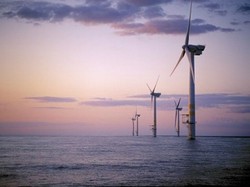Challenging conventional wisdom on renewable energy's limits
 In making the case for a rapid conversion away from heavily polluting energy sources like coal and nuclear power to cleaner generation, renewable energy advocates often confront the argument that their scheme is impossible due to the intermittent nature of sun and wind.
In making the case for a rapid conversion away from heavily polluting energy sources like coal and nuclear power to cleaner generation, renewable energy advocates often confront the argument that their scheme is impossible due to the intermittent nature of sun and wind.But a groundbreaking study out of North Carolina challenges that conventional wisdom: It suggests that backup generation requirements would be modest for a system based largely on solar and wind power, combined with efficiency, hydroelectric power, and other renewable sources like landfill gas.
"Even though the wind does not blow nor the sun shine all the time, careful management, readily available storage and other renewable sources can produce nearly all the electricity North Carolinians consume," said author John Blackburn, professor emeritus of economics and former chancellor at Duke University in Durham, N.C.. He's also the author of the books "The Renewable Energy Alternative" and "Solar in Florida."
The study was published last week by the Maryland-based Institute for Energy and Environmental Research, whose executive director, Arjun Makhijani, called it landmark research. "North Carolina utilities and regulators and those in other states should take this template, refine it, and make a renewable electricity future a reality," he said.
Blackburn used hourly North Carolina wind and solar data for a total of 123 days in the sample months of January, April, July and October, with samples taken at three wind and three solar sites across the state. Solar and wind power generation were then scaled up to represent 80% -- 40% each -- of average utility loads for the sample months, with the rest coming from the existing hydroelectric system (8%) and assumed biomass co-generation (12%).
The study figured in projected energy efficiency by assuming an annual utility load of 90 billion kilowatt-hours, slightly less than the current 125 billion kWh load, and by calculating average hourly loads from Duke Energy's 2006 load profile with modifications to show some reduction in summer and winter peaks due to more efficient buildings. It also assumed increased storage capacity from a smarter electrical grid.
In the end, with those conditions met, Blackburn calculated that the required auxiliary generation from conventional power plants to fill in the gaps would amount to only 6% of the annual total generation required to meet demand in North Carolina.
"This goes to the heart of the argument by power companies that have long dismissed solar and wind as future technologies," said Jim Warren, executive director of the N.C. Waste Awareness and Reduction Network, a Durham, N.C.-based nonprofit that provided research assistance to Blackburn.
The study was released just days after a new poll from Elon University in Elon, N.C. found overwhelming public support in North Carolina for developing the state's renewable energy capacity. Nearly 80% of the poll's respondents said they favor new wind energy facilities in the mountains or on the coast, while more than 83% favor construction of solar facilities.
Tags
Sue Sturgis
Sue is the former editorial director of Facing South and the Institute for Southern Studies.
